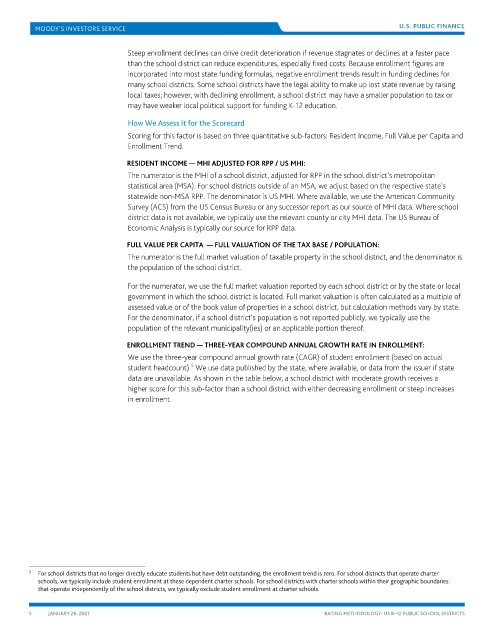Page 1639 - draft
P. 1639
U.S. PUBLIC FINANCE
Steep enrollment declines can drive credit deterioration if revenue stagnates or declines at a faster pace
than the school district can reduce expenditures, especially fixed costs. Because enrollment figures are
incorporated into most state funding formulas, negative enrollment trends result in funding declines for
many school districts. Some school districts have the legal ability to make up lost state revenue by raising
local taxes; however, with declining enrollment, a school district may have a smaller population to tax or
may have weaker local political support for funding K-12 education.
How We Assess It for the Scorecard
Scoring for this factor is based on three quantitative sub-factors: Resident Income, Full Value per Capita and
Enrollment Trend.
RESIDENT INCOME — MHI ADJUSTED FOR RPP / US MHI:
The numerator is the MHI of a school district, adjusted for RPP in the school district’s metropolitan
statistical area (MSA). For school districts outside of an MSA, we adjust based on the respective state’s
statewide non-MSA RPP. The denominator is US MHI. Where available, we use the American Community
Survey (ACS) from the US Census Bureau or any successor report as our source of MHI data. Where school
district data is not available, we typically use the relevant county or city MHI data. The US Bureau of
Economic Analysis is typically our source for RPP data.
FULL VALUE PER CAPITA — FULL VALUATION OF THE TAX BASE / POPULATION:
The numerator is the full market valuation of taxable property in the school district, and the denominator is
the population of the school district.
For the numerator, we use the full market valuation reported by each school district or by the state or local
government in which the school district is located. Full market valuation is often calculated as a multiple of
assessed value or of the book value of properties in a school district, but calculation methods vary by state.
For the denominator, if a school district’s population is not reported publicly, we typically use the
population of the relevant municipality(ies) or an applicable portion thereof.
ENROLLMENT TREND — THREE-YEAR COMPOUND ANNUAL GROWTH RATE IN ENROLLMENT:
We use the three-year compound annual growth rate (CAGR) of student enrollment (based on actual
student headcount). We use data published by the state, where available, or data from the issuer if state
5
data are unavailable. As shown in the table below, a school district with moderate growth receives a
higher score for this sub-factor than a school district with either decreasing enrollment or steep increases
in enrollment.
5 For school districts that no longer directly educate students but have debt outstanding, the enrollment trend is zero. For school districts that operate charter
schools, we typically include student enrollment at these dependent charter schools. For school districts with charter schools within their geographic boundaries
that operate independently of the school districts, we typically exclude student enrollment at charter schools.
5 JANUARY 26, 2021 RATING METHODOLOGY: US K–12 PUBLIC SCHOOL DISTRICTS

